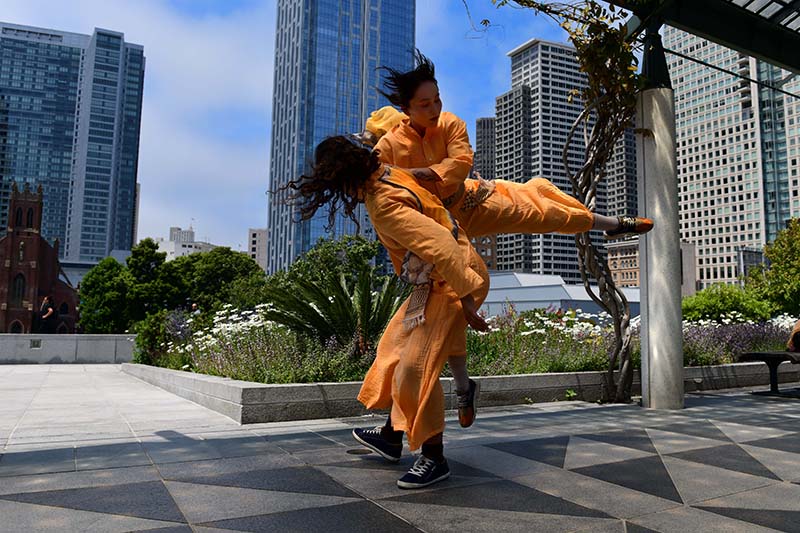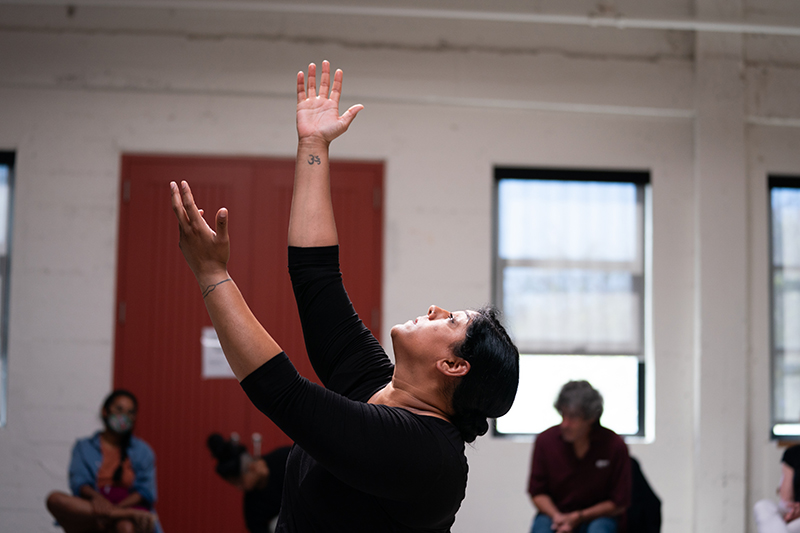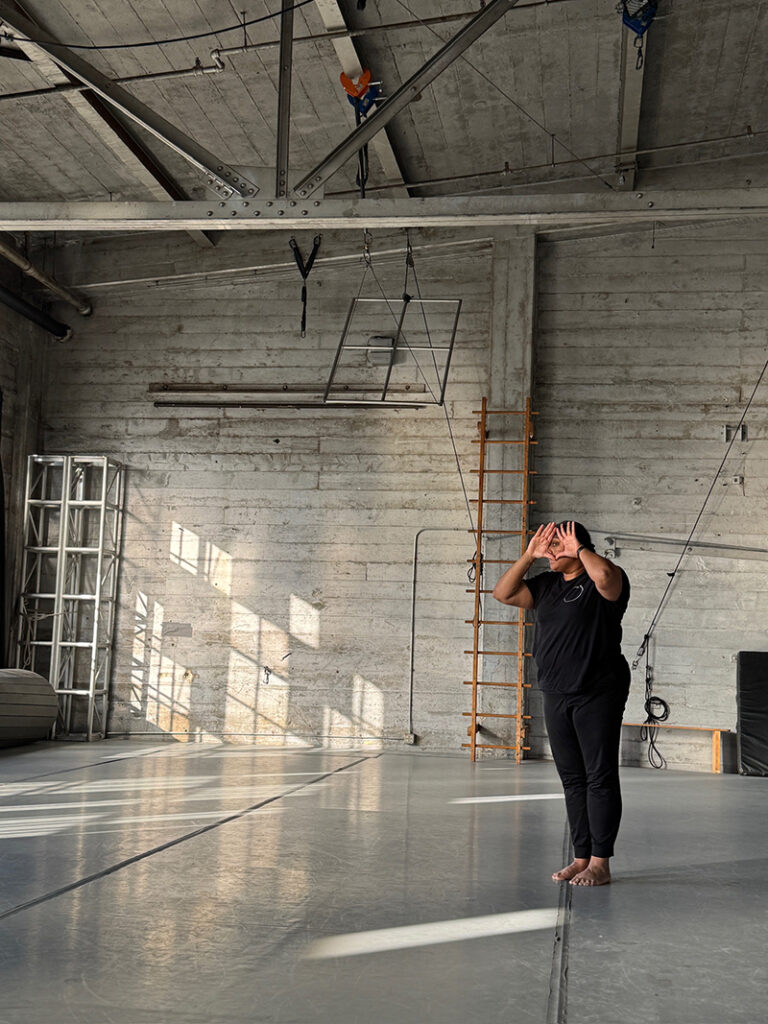getting the wild light into my bones
November 17, 2025
BY BHUMI B PATEL
“You could say and not lie
that this is most of what I long for in the way
of distance and the way of desire: may the fetters
fall from all of us this year. May the wild light
get way down in our bones. May we without requital,
mercy one another with hands like wings,
with unarmed hands.”
from Corrie Williamson’s Mercy Me
I am seeking ways to be hopeful. Perhaps you are too. When I think about the first quarter of the 21st century and the accumulation of challenges and crossroads for the future of humanity, I can’t unsee the ways that oppression and domination continue to morph, but also give birth to new forms of resistance. My own heart is in turmoil, caught in multiple crises on the personal, professional, and global scales. Much of my creative work asks me to turn toward feeling as a starting point for understanding the world around me. Audre Lorde said, “our feelings are our most genuine path to knowledge” (Tate 2004, 91). So, in this writing I invite you to feel alongside me.

wild light at Yerba Buena Gardens Festival. Photo by Jim Watkins. Dancers Maxine Flasher-Düzgüneş and Ài Yīn 艾音 Adelski
In 2022, I published a piece for Stance on Dance, in search of a decolonial performance praxis, in which I was tussling with decolonization, performance praxis, queerness, and non-linearity. During this time, I was also completing a PhD in Dance Studies. In my dissertation, I was exploring these questions of decolonial performance praxis and how the AIDS epidemic continues to haunt how queer artists make performance. I proposed that futurist imaginings and world-building are essential tools to resist and endure the confines of the oppressions that plague the present and past. In that project, I focused on artists who have taught me and guided my own journey as an artist, and as my questions have continued to bubble to the surface I now turn to myself to understand queer decoloniality performance praxis. Since I published that article I have continued to write and make performance works to excavate these big ideas about humanity and our very interconnected existences. In the time since publishing that piece, I have been working to create performances that address the many facets of queer, decolonial performance praxis that give me pause. In the 2022 article, I proposed that,
Perhaps to create decolonial performance praxis is to challenge the hegemonic histories of marginalization as a singular, forward-progressing trajectory that is divided into movements or waves or phases. Often this singularity leads to hegemonic viewpoints of timelines of liberation. This, in turn, misrepresents and curtails the ways in which liberatory practices and activisms can be related, conceptualized, and mobilized toward a point at which we never arrive. Perhaps a decolonial performance praxis centers the relationship between liberatory practices and activisms, moving us toward the unarrivable horizon (Patel 2022).
And I still believe it. I concluded the piece by proposing that perhaps “we’re all just time travelers moving through time and space, bundled together past present future selves reaching out to find home” which led me almost directly into my next choreographic reckoning (Patel 2022). I have been reaching out to find home, and the time to share it publicly has arrived. In December 2025, I, with my company pateldanceworks, will premiere a futurist performance work called wild light as an attempt to embody and future the liberations of minoritarian humans and our more-than-human kin. It is an embodiment of non-linear liberatory practices that leaves many questions unanswered and unsatisfied.

wild light, Photo by Robbie Sweeny. Dancer: Bhumi B Patel
A few years ago, I read Donna Haraway’s Staying with the Trouble: Making Kin in the Chthulucene, and was in raptures at her ideas about tentacular thinking, her call to stay with the trouble of living and dying on a damaged earth, and her speculative fiction demonstrating how we might build more livable futures that bridge the divide between the human and more-than-human. One particular speculative writing, “The Camille Stories: Children of Compost” made its way into my body, and I couldn’t help but want to dance through the fragments of Camille, who Haraway says “is a keeper of memories in the flesh of worlds that may become habitable again” (Haraway 2016, 134). For Haraway, “‘The Camille Stories’ are invitations to participate in a kind of genre fiction committed to strengthening ways to propose near futures, possible futures, and implausible but real nows” (Haraway 2016, 136). And within my own process, I have not been able to conjure a utopia on stage (and why would we want to?). Instead, I have used this creative process to create what Anna Tsing calls the “impossible present, this time of rupture, a world haunted with the threat of extinction” more bearable for us (Tsing 2017, G6). My process makes space to challenge assumptions of what a queer of color artist should be making. I create the future world I want to see, through performance, rehearsing on-stage the worlds I want to see off-stage.
In the story, Haraway creates a speculative fabulation that follows five generations of a symbiogenetic join of humans and monarch butterflies in order to support both species’ survival(s). Each generation follows a symbiont named Camille, and traces the challenges and beauties unique to each generation. The Camilles experience friendship, heartbreak, migration, and hopelessness that carry them onward. Haraway found a way to imagine how, “drawing from long histories of creative resistance and generative living in even the worst circumstances, people everywhere found themselves profoundly tired of waiting for external, never materializing solutions to local and systemic problems” (Harway 2016, 136). By the time we arrive at Camille 5, whose death in 2425 marks the end of the story and where Haraway leaves us, the future is still uncertain. These symbionts have done the work of attempting to create conditions under which endangered species (humans included) can survive, but there is simply no guarantee. That is the way of things. So hope, in the process of making this work, lies not in a predetermined outcome of survival, or a promise of a future, but rather lies in the ways that I have been able to allow myself to be undone by the process of making a queer of color choreography that is necessary to this moment through improvisational practices that afford us the capacity to imagine futures otherwise.

wild light, Photo by Robbie Sweeny. Dancer: Bhumi B Patel
This project remains grounded both in the dance, but also in the relationships forged in making the dance possible. Mariame Kaba writes, “everything that is worthwhile is done with other people” and so that is what I set out to do (Kaba 2021, 178). I had a deep desire to do something worthwhile with other people so that there might be visibility and understanding in minoritarian improvisations that privilege ways of knowing outside of the boundaries of white supremacy culture. In creating the world of the piece, I have collaborated with sonic composer Rachel Austin, who has worked with pateldanceworks since 2017, to create an often sensuous, sometimes absurd, and deeply-felt sonic world. One of my new collaborators, visual artist Sa’dia Rehmen has designed visual elements for the space that bring nature indoors and marry industrial and natural elements to create the ghosts of somewhere else. The performers of the work, Ài Yīn 艾音 Adelski, Catalina O’Connor, Maxine Flasher-Düzgüneş, monique jonath, and myself, move nimbly through both choreographic material and improvisational practices which has made space to be together in practice of something other than the here and now that we have. Catalina and monique are new to the company, and Ài Yīn and Maxine have danced with the company before. Getting to bring all of us together into improvisational practices of trust, love, and generosity has imbued our space together with a palpable energy. Our survival(s) depend upon our capacity for connection and dreaming that another world is possible, and we get to do that together.
I believe that we can use the tools of improvisation to move toward our own liberations, meeting every challenge and obstacle. I primarily work in improvisational practice and somatic listening which mirrors the fragmentation and non-linearity of my experiences with the way that I feel resistance in the world operates. I’ve often said that to make work, both in the realms of artistic and scholarly practice, as climate, humanitarian, and public health crises unfold across the globe with increasing urgency, is to work with a tender heart that is broken open, searching for light.
I have been in the creative process for this work while a global pandemic rages on, and humanitarian crises unfold in the US, the Occupied Palestinian Territories, Lebanon, Sudan, the Democratic Republic of Congo, Bangladesh, and more. Events such as the US-supported military assault by the Israeli government on Gaza, the West Bank, and Lebanon, the growing global anti-migrant sentiments, a continued pandemic of racism, the vilification of equity, diversity, and inclusion policies in the US, the ongoing attacks on LGBTQ people’s rights to use bathrooms, participate in sports, and even go by the name of their choosing, the ongoing repercussions of the Supreme Court’s 2022 overturning of Roe v. Wade (1973) leading to the endangerment and deaths of pregnant people across the country, and the climate crisis and accompanying natural disasters, all highlight a rise in state-sanctioned violence, racial injustice, and an increasingly divisive hostile landscape.

wild light at Yerba Buena Gardens Festival. Photo by Jim Watkins. Dancer: Maxine Flasher-Düzgüneş
So then what do we do?
Arundhati Roy writes that in these moments, our strategy must be “to lay siege to [empire]. To deprive it of oxygen. To shame it. To mock it. With our art, our music, our literature, our stubbornness, our joy, our brilliance, our sheer relentlessness – and our ability to tell our own stories. Stories that are different from the ones we’re being brainwashed to believe” (Roy 2003, 112). So I hope that this work continues to mock empire because those of us who bear the consequences of local and global instabilities continue to turn back to the body. We keep dancing, we keep marching, we keep speaking. And we continue to improvise toward our own liberations, meeting every challenge and obstacle. I am hopeful you will improvise alongside me.
~~
pateldanceworks presents wild light
December 4-6, 2025 at 7pm; December 7, 2025 at 3pm
ODC Theater, San Francisco

Photo by Em Kane. Dancer: Bhumi b Patel
~~
References:
Haraway, Donna. 2016. Staying with the Trouble: Making Kin in the Chthulucene. Duke University Press.
Kaba, Mariame. 2021. We Do this ‘Til We Free Us: Abolitionist Organizing and Transforming Justice. Haymarket Books.
Patel, Bhumi. 2022. “in search of a decolonial performance praxis.” Stance on Dance (1): Spring/Summer 2022.
Roy, Arundhati. 2003. War Talk. South End Press.
Tsing, Anna Lowenhaupt. 2017. Arts of Living on a Damaged Planet: Ghosts of the Anthropocene. University of Minnesota Press.
Tate, Claudia. 2004. “Audre Lorde.” In Conversations with Audre Lorde, edited by Joan Wylie Hall. University Press of Mississippi.
~~
Dr. Bhumi B Patel (she/they) is a queer home-seeker and science fiction choreographer, director of pateldanceworks, and writer. Patel tends to her desires to create liberatory, nourishing community spaces through dancing, choreographing, curating, teaching, and scholarship. Patel earned her MA in American Dance Studies from Florida State University and her MFA in Dance from Mills College. She engages with curatorial practices for both performance and writing and has presented her scholarly and performance work nationally and internationally. Patel serves as Editorial Assistant for Choreographic Practices and was a Women of Color in the Arts Leadership Fellow, a 2022-2023 Dance/USA Fellow, and a 2023 YBCA 100 Honoree. Bhumi’s research on queer decoloniality and improvisation intersects with her performance-making as a way of tracing the deep connections of past, present, future to build communities of nourishment and care.

Responses
There are no comments at this time.
Be the first to start the discussion by filling out the comment form.